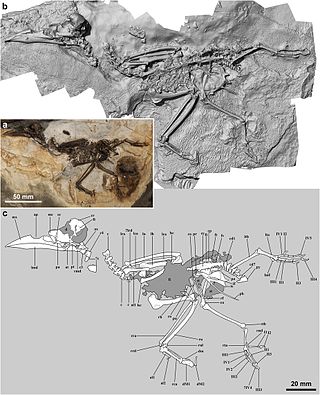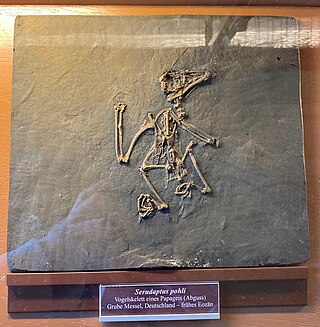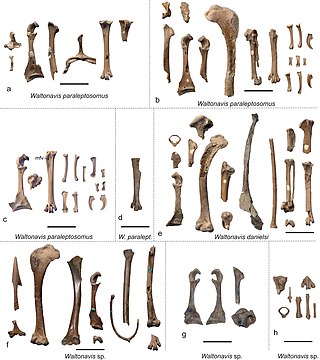
Masillaraptor is an extinct genus of masillaraptorid, a group of primitive falconiforms, from the Middle Eocene Messel Pit, Germany. It is a long-legged relative of the living falcons.
Eurofluvioviridavis is a genus of extinct primitive birds from the Middle Eocene Messel Pit, Germany. It contains a single species, Eurofluvioviridavis robustipes. It is related to Avolatavis and Vastanavis, other members of the family Vastanavidae.
Eostrix is a genus of extinct primitive owls in the family Protostrigidae, along with Oligostrix and Minerva. These owls date from the early Eocene of the United States, Europe, and Mongolia. They have been described based on fossil remains. The genus was created by Pierce Brodkorb in 1971 to place a fossil species known until that time as Protostrix mimica.

Juncitarsus is an extinct genus of wading birds from the Eocene of the United States and Germany. Though previously considered a flamingo, it is likely a stem-flamingo, possibly a relative of the group which contains both flamingos and grebes (Mirandornithes).

Septencoracias is an extinct genus of bird related to modern rollers and other Coraciiformes such as kingfishers, bee-eaters, motmots, and todies. It contains two species, Septencoracias morsensis described in 2016, and S. simillimus, which was named in 2024. It was found in the Fur Formation of Denmark, dating back to the Ypresian of the Lower Eocene Epoch, about 54 million years ago. Septencoracias is one of the earliest known members of Coraciiformes, lending insight into the earliest radiation of this group.

Messelasturidae is an extinct family of birds known from the Eocene of North America and Europe. Their morphology is a mosaic that in some aspects are very similar to modern hawks and falcons, but in others are more similar to parrots. Initially interpreted as stem-owls, more recent studies have suggested a closer relationship to parrots and passerines. Their ecology is enigmatic.

Halcyornithidae is an extinct family of telluravian birds thought to be related to the Psittaciformes (parrots), Passeriformes (songbirds), and to the extinct Messelasturidae. Halcyornithids have been found in various Eocene formations in Europe and North America. Widespread and diverse in the Early Eocene of North America and Europe, halcyornithids are not found in locales later than the Middle Eocene. Halcyornithids were small, arboreal birds with zygodactyl feet, with two toes facing forwards and two facing back, a trait shared with other tree-dwelling families of Eocene birds like the Zygodactylidae and the messelasturids. The skull of halcyornithids features a ridge of bone above the eye called the supraorbital process, similar to birds of prey. The relationships of the halcyornithids to other birds remain uncertain. Halcyornithids have been proposed as relatives to owls and as a lineage closer to parrots than to songbirds. Most recently, halcyornithids have been identified as the sister group of the clade including parrots and songbirds. It is also possible that Halcyornithidae is paraphyletic with respect to the Messelasturidae.
Morsoravis is an extinct genus of neoavian bird from the Early Eocene Fur Formation of Denmark. It contains a single named species, Morsoravis sedilis. Fossils of Morsoravis have also been found in the Green River Formation of Wyoming and possibly the Nanjemoy Formation of Virginia.

Allgoviachen is an extinct genus of anatid bird from the Late Miocene (Tortonian) Hammerschmiede clay pits of Bavaria, Germany. The genus contains a single species, A. tortonica, known from bones belonging to the left leg.
Danielsraptor is an extinct genus of masillaraptorid bird from the Early Eocene (Ypresian) Walton Member of the London Clay Formation in Essex, United Kingdom. The genus contains a single species, D. phorusrhacoides, known from a partial skeleton.
Nasidytes is an extinct genus of loon (Gaviiformes) that lived during the early Eocene in what is now Great Britain. It contains a single species, N. ypresianus. Nasidytes is the earliest unambiguously identified loon in the fossil record.

Tonsala is an extinct genus of Plotopteridae, a family of flightless seabird similar in biology with penguins, but more closely related to modern cormorants. The genus is known from terrains dated from the Late Oligocene of the State of Washington and Japan.

Lutavis is an extinct genus of potentially afroavian bird from the Early Eocene London Clay Formation of Essex, United Kingdom. The genus contains a single species, L. platypelvis, known from a partial skeleton.

Waltonavis is an extinct genus of potentially leptosomiform bird from the Early Eocene London Clay Formation of Essex, United Kingdom. The genus contains two species: W. paraleptosomus and W. danielsi, both known from partial skeletons.

Psittacomimus is an extinct genus of psittacopedid bird from the Early Eocene London Clay Formation of Essex, United Kingdom. The genus contains a single species, P. eos, known from a partial skeleton.

Minutornis is an extinct genus of parapasserine bird from the Early Eocene London Clay Formation of Essex, United Kingdom. The genus contains a single species, M. primoscenoides, known from a fragmentary skeleton.
Charadriisimilis is an extinct genus of charadriiform birds from the Early Eocene (Ypresian) London Clay of Walton-on-the-Naze, United Kingdom. The genus contains a single species, Charadriisimilis essexensis, known from partial postcranial remains.
Pulchrapollia is an extinct genus of halcyornithid bird from the Early Eocene London Clay of Walton-on-the-Naze, United Kingdom and the Nanjemoy Formation of Virginia, United States. The genus contains three species, Pulchrapollia gracilis, Pulchrapollia tenuipes and Pulchrapollia eximia.
Pseudasturides is an extinct genus of halcyornithid bird from the Middle Eocene Messel pit in Hesse, Germany, and possibly the Isle of Sheppey, United Kingdom. The genus is represented by a single species, Pseudasturides macrocephalus.
Sororavis is an extinct genus of bird from the Early Eocene London Clay of Walton-on-the-Naze, United Kingdom. It contains a single named species, Sororavis solitarius. It is a member of the Morsoravidae.














